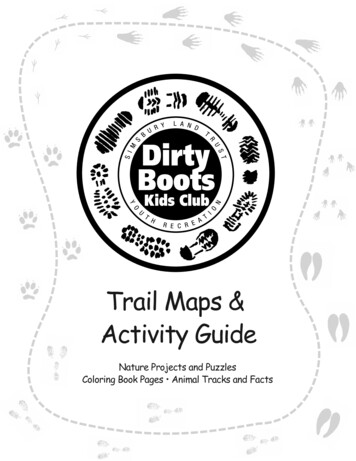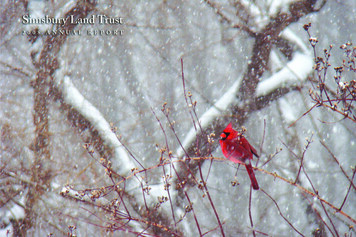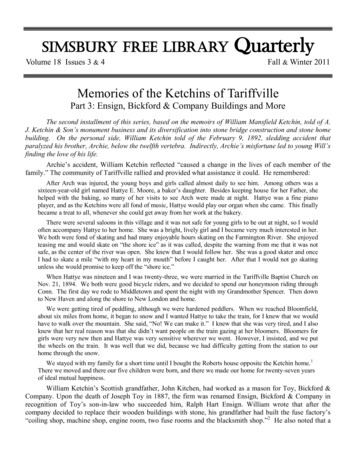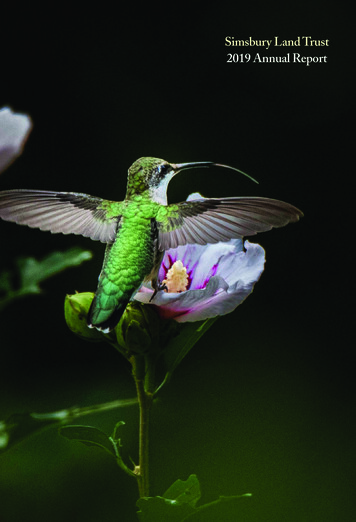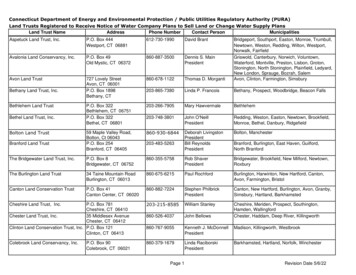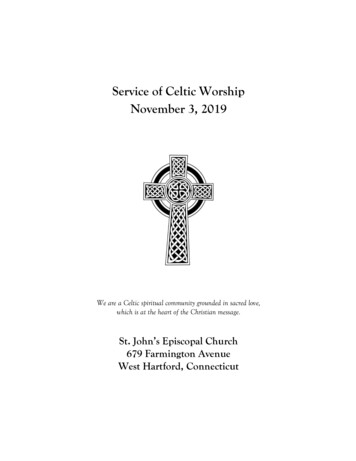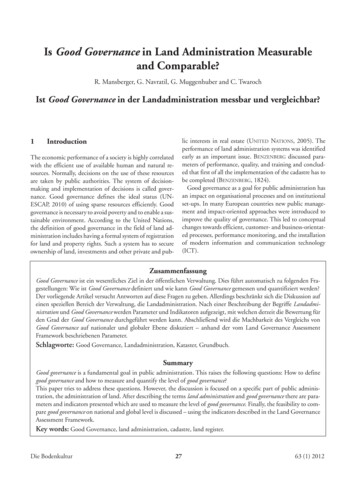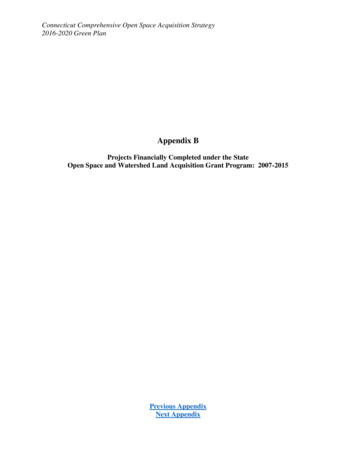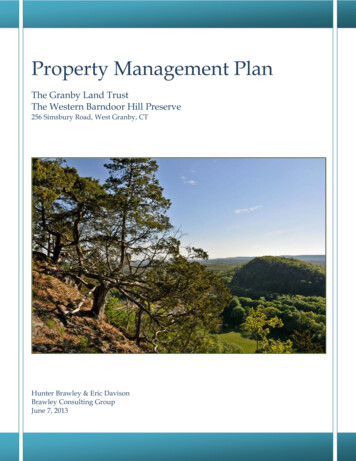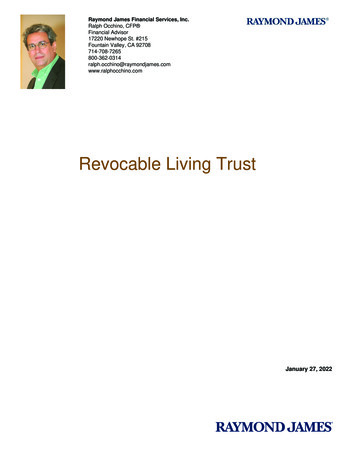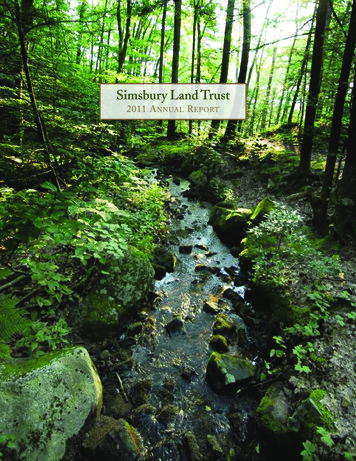
Transcription
Simsbury Land Trust2011 A NNUAL R EPORT
2011-2012BOARD OF TRUSTEESChuck Howard, PresidentTed Almy, Vice PresidentKaren Brand, SecretaryBob Ellis, TreasurerChad AlfeldJoan AllenBob BinghamDick DavisT.J. DonohueFred FeibelKatie FrenchRob HeagneySally RiegerElliot SchulmanLaura St. OngeAnupam TantriKelley WeikelMargery Winters, Ex OfficioS TA F FAmy Zeiner, Executive DirectorPatricia Hazelwood, Director,Finance and MembershipBill CoxCandace FitzpatrickHerman FonteyneBill HowardPaul KnierimMike LongJim VeltropOur MissionCONTENTSThe Simsbury Land Trust is a not-for-profit organization whose mission is to protect scenic vistas, geologicalfeatures and farmland that visually define Simsbury’s character and provide healthy habitats for local wildlife andplants. Our goal is to consistently craft, support and implement creative land conservation solutions for thebenefit of present and future generations.1Letter from the President2Financial Highlights4Map of SLT Properties5New Children’s Program6Preservation in PerspectiveAcquisitions: Soliciting and accepting gifts of land and interests in land from individuals and businesses.7Stewardship of OurPropertiesPartnerships: Partnering with individuals, organizations, and governmental entities to accomplish our goals.10 Stewardship in Action14 Membership DonationsThe Simsbury Land Trust seeks to accomplish its mission through:Advocacy: Participating in public policy dialogue at the local and state levels, in public and private forums.Stewardship: Managing and using acquired properties in a manner consistent with our mission.Legacy Building: Soliciting donations from individuals, organizations, foundations and businesses.COVER PHOTO: JAY SAMSPHOTO: LAWRENCE BOBLASADVISORY BOARD
Letter from the PresidentThe most visible activity of the Simsbury Land Trust for thepast few years has been the acquisition of development rightsto preserve Tulmeadow Farm. We closed on the 73-acreTulmeadow Woodlot last Fall, bringing a close to theCampaign for Simsbury. During this ten-year campaign we wereable to protect permanently an additional 657 acres, bringingthe total number of acres under protection to 967. This wouldnot have been possible without thestrong support of our members andresidents of the Town of Simsbury.The preservation of theTulmeadow Woodlot was also madepossible by the support and cooperation of the town, state, and federalgovernments. It literally took an actof Congress for the Simsbury LandTrust to receive the 1.415 millionForest Legacy Grant that providedthe lynchpin financing for thepurchase of the development rightsfor the Tulmeadow Woodlot. It wasonly after we had been awarded thisgrant, as well as other grants fromthe Connecticut Department ofEnergy and Environmental Protection (DEEP), the Richard P. Garmany Fund from theHartford Foundation for Public Giving, and the Town ofSimsbury, that we were informed that there were restrictionsthat precluded the Simsbury Land Trust itself from holdingtitle to the development rights easement for which the grantwas awarded. By working together, we found a way for theSimsbury Land Trust to acquire an access easement and for theTown of Simsbury to hold the conservation easement, whichthe Simsbury Land Trust, acting as the agent for the state andfederal governments, will monitor.Although the Campaign for Simsbury is over, our work isnot done. We are continuing to identify and explore additionalopen space preservation opportunities. We have made muchprogress in strengthening the organizational fundamentals ofthe Simsbury Land Trust. We have also expanded our stewardship efforts and increased our member activities by offeringadditional hikes and education programs.During 2011 we completed and adopted a new strategicplan that will guide our activities and operation over the nextfive years. With the help of a grant from the Connecticut LandConservation Council and the Hartford Foundation for PublicGiving, we began a comprehensiverecords management program todigitize our recordkeeping and toensure that we properly documentour acquisition and maintenanceactivities. In addition, we conducteda membership survey and held focusgroup meetings to help us learnwhat is important to the residents ofSimsbury and how we can betterfulfill our mission.The Simsbury Land Trustoffered a full schedule of over 20hiking activities and programs in2011. We were impressed by theattendance at the educationprograms, often filling the meetingroom of the Simsbury Library. Ifyou haven’t already signed up for our email newsletter to receiveup-to-date notices and reminders about these activities andprograms, please go to our website and sign up for our emailnotification list so you don’t miss out on our events.Thank you for your role in the success of the Campaignfor Simsbury and for your continued support as we moveforward in acquiring, preserving, and using the wonderful landresources in Simsbury.Chuck HowardPresident1
Financial Highlights – 2011Statement of Revenuesand ExpensesRevenuesCampaign DonationsGrantsLand DonationsAnnual Appeal IncomeMembership ContributionsArt AuctionSimsburyopoly IncomeMiscellaneous IncomeTotal RevenuesExpensesAdministrativeSalaries and BenefitsMembershipAcquisition ExpensesStewardshipArt Auction ExpenseSimsburyopoly ExpenseDepreciationTotal ExpensesSignificant events in 2011Excess of RevenuesOver Expenses2August Town MeetingDue to the programmatic constraints of the Forest Legacy Grant, the onlyoption for the preservation of the Tulmeadow Woodlot was for the Tuller familyto grant the Simsbury Land Trust an access easement and for the Town ofSimsbury to hold the development rights conservation easement. Under thisarrangement, the Simsbury Land Trust could contract with the state tobecome the monitoring agent for the conservation easement, and the transaction could move forward. A town meeting, however, was required in orderfor the Town of Simsbury to be authorized to accept an assignment of moneyand rights from the Simsbury Land Trust and to accept the conservation easement. With great support from town officials and the town’s boards andcommissions, a town meeting was scheduled for August, 2011 at which theissue was presented to town meeting electors. Not only was there a fabulousattendance at this meeting, there were no votes against the proposal. Weare grateful for the great support shown by the attendance of members atthe town meeting and for our strong partnership with the Town of Simsbury.January 1 – December 31, 2011CAMPAIGNOPERATIONS14,6212,195,000 3,24087313,2408731,14833,251135,282168,533188,946 2,176,520 23,297 2,199,817 2,037,186 TOTAL 2011TOTAL 2010 226,58344,3021,800,00042789,65548,166By working together, we were able to accomplish the task of preserving thelast remaining portion of Tulmeadow Farm, which will benefit our town forgenerations to come.Tulmeadow CelebrationThe Simsbury Land Trust holds a membership celebration each year, but thecelebration we held in September was particularly special. Once it becameclear that we would be able to conclude the Tulmeadow Woodlot transactionwith the assistance of the Town of Simsbury, we planned a party — and whata party it was. We had a barbecue, hayrides,hikes, music, and even a program for kids onreptiles (complete with snakes and other critters). There were a few speeches andpresentations, but it was a terrific party —perfect for kids, parents, grandparents andeveryone else who loves being outdoors on a
Balance SheetDECEMBER 31, 2011AssetsCURRENT ASSETSCash – Unrestricted– RestrictedPledges Receivable – netPrepaid ExpensesInvestments Held by Others 184,92262,6503336,69352,760DECEMBER 31, 2010 310,395356,072258,20111,25456,409TOTAL CURRENT ASSETS307,358992,331FIXED ASSETSLandOffice Equipment – net14,267,88588111,412,4381,754TOTAL FIXED ASSETS14,268,76611,414,192 14,576,124 12,406,523TOTAL ASSETSLiabilities and Fund BalanceCURRENT LIABILITIESNote PayableAccrued LiabilitiesTOTAL CURRENT LIABILITIESFUND BALANCEBeginning Fund BalanceBoard Designated Stewardship FundRestricted Stewardship FundTemporarily Restricted Net AssetsExcess of Revenues over ExpensesENDING FUND BALANCETotal Liabilities and Fund Balance1,329 2,199,81710,047,29630,0002,295258,2012,037,186 14,574,79512,374,978 14,576,124 12,406,523beautiful autumn day. We have events like this every year, and we urge youto consider making our membership celebration an annual event for yourfamily. It is a perfect opportunity to renew your ties to the Simsbury LandTrust and to just have a good time.U.S. Department of Agriculture MeetingWe are proud of what the Simsbury Land Trust, thanks to the support of ourmembers and donors, has been able to accomplish in preserving open spacein Simsbury. Of course, much of this would not have been possible withoutgrants and strong support from government officials and agencies at thestate and federal levels. But we discovered last fall that Connecticut andfederal officials are also proud of the preservation efforts of the SimsburyLand Trust, because they asked the Tuller family and the SLT to host ameeting with Harris Sherman, the Undersecretary of the U.S. Department ofAgriculture for Natural Resources and the Environment, on his trip toConnecticut. Since Secretary Sherman has direct responsibility for theU.S. Forest Serviceand the NaturalResources Conservation Service, two ofthe federal agenciesthat have providedgrants to the Simsbury Land Trust, it was clear that this would be an importantopportunity to speak with key government decision-makers.This meeting was the only land trust stop made by SecretarySherman during his visit to Connecticut, and we were joined by a veritable“who’s who” of leading state and federal conservation officials in Connecticutfor a roundtable discussion on ways that government can work with privateorganizations to leverage conservation dollars. We felt honored to have beenasked to help host this meeting and we believe it demonstrates that ourefforts and success are viewed by others as a model of what can be accomplished by a strong local organization with committed supporters.3
SIMSBURY LAND TRUST PROP1ERT 253027MAP : DON RIEGER14Since 1976, the Simsbury Land Trusthas protected 31 properties covering 967 acres in Simsbury123454CannonCathlesFriedmanHendrickThe Master’sSchool6789101112Fonteyne60 ulmeadow FarmRose/KrasnogerCarlsonBergmanWeldenJamesKetchin dale anderman #2GloverWagner Woods
New Children’s Program and Trail GuideIncreasing the number of familyand kid friendly activities forSimsbury Land Trust membersand area residents has been a goalof the Education andRecreation Committeethis year. We are in theprocess of creating anoutdoorexplorationprogram for children. Anactivity book with trailmaps and trail information for children and their familiesto use while exploring the SLT trails is being developed, andshould be available for distribution later this year. This bookwill be printed this fall and will be available for downloadon the SLT website as well.Several family events are already planned for thisspring, and we hope to add more this fall. If you are interested in signing up to receive information on the trail guideand the children’s program please be sure to visit our websiteand opt in to our email news list. We are always looking for newcommittee members to help us plan our programs, so please contactthe office if you are interested in helping us plan activities for thisexciting new children’s program.5
Preservation in Perspective —Keeping Our PromiseWhenever the question arises as to whether to spend the next dollar,or the next measure of time and effort, on acquiring a new propertyor on caring for the land we already own, the Simsbury Land Trusthas always been quick to choose the new acquisition. Time is short,opportunities are finite and if we do not protect certain land whenwe can, we might never have another chance. We still believe in thatand the truth is deferred maintenance, as long as you do not waittoo long, can often be remedied down the road. However, thischoice has other implications for a land trust.When the Simsbury Land Trust promises to preserve aspecial place — a favorite vista, a secluded stream, a corridor linkor a challenging trail — we do not just mean that the land willremain undeveloped. We mean that we will doour best to maintain or enhance the characteristics that make each place special.People sometimes question this objective.Why not simply leave the land alone and letnature run its course? After all, aren’t we tryingto preserve it in its natural condition? Unfortunately, in a densely populated community likeours, we have already modified our natural environment, and do so every day, often in wideranging and traumatic ways. For example:1) A new development replaces an absorbenthillside, creating runoff from rooftops andpavement and overwhelming the streamon an adjacent property, changing itsstability and ecology. This does nothappen slowly, enabling the plants andanimals the time to adjust. It happensquickly and aggressively.62) We purchase a beautiful ornamental shrub,transported by a nursery from thousands ofmiles away and plant it in our yard. A flock ofbirds eat the seeds and drop them in the nearbywoods where the plant spreads quickly, a singleforeign species with no natural enemies, replacing what had been a diverse variety of nativeplants.3) We no longer take the time or spend themoney to mow a field that provides a panoramicview and a home for grassland birds andmammals. Soon the field has grown to brushand trees, the field habitat and the view are gone.The Simsbury Land Trust would arguethat we are not doing the job we set out to dowhen we neglect these things. With thoughtfulplanning, professional skills, hard work andfinancial resources we can slow the run-off andcatch the sand and salt before they enter the stream. We cannoteradicate an invasive species but we can control it and keep it fromdestroying the wide diversity of our native plants and animals. Andby maintaining a field, we can save the scenic vista and a diversehabitat, elements that add immeasurably to the healthy vibrancy ofthe world that supports our mind, our body and our happiness.If the Simsbury Land Trust does not make active management of the land an integral part of our operations, we only do halfthe job. At the end of the day, we must provide the same level ofeffort and resources to caring for those special places that we did inacquiring them. Only then have we truly preserved them and keptour promise.
Stewardship of Our PropertiesTrail Building and MaintenanceSimsbury Land Trust properties are open to the public. The SLTworks hard to make sure that the public can enjoy their visits byproviding well designed, marked and maintained trails that offerthe opportunity to explore the properties while at the same timeprotecting their natural features such as wildflowers and wildlife.Developing a new trail may involve consulting professionals suchas a botanist, herpetologist (a person who studies amphibians andreptiles) or other knowledgeable naturalists to make sure that weroute the trail in such a way that special plants and animals and theresources they use will be protected. Sometimes we designate areasas environmentally sensitive and ask the public not to enter.Once a good route for a trail is defined, land trust volunteersuse flagging tape to mark the route of the trail so that workdayvolunteers can help cut back brush, cut small trees, move rocks andmake other necessary changes to create an open pathway. When theground work is finished, the trail is blazed, marked with smallpainted rectangles on trees and occasionally rocks to show the route.Did you know that twoblazes together, one abovethe other, means that thetrail is about to turn? If theupper blaze is to the rightof the lower blaze, look forthe trail to turn right. Ablaze to the left of thelower blaze means the trailis about to turn left. Blazesare placed so that you cansee the next blaze from theone you are standing nearexcept when the trail is anold road or other obvioustravel way.All trails require repeated maintenance. The October snowstorm resulted in many downed trees blocking trails and paths, buteven under normal conditions bushes grow back after being cut andtrees die and fall. The obstacles have to be addressed regularly.Road, Case Meadow, Wagner Woods and Owen-Mortimer. Thesmall log bridge in the Wagner Woods will be replaced in spring of2012 with a higher bridge that offers better footing.Boardwalks help keep walkers from getting wet, muddy feet,help prevent erosion and protect many plants in wet areas frombeing trampled. There is a long stretch of boardwalk at the OwenMortimer property and shorter boardwalks at 60 Westledge Road,the West Mountain blue trail and the Knapp property where oneboardwalk ends at a viewing platform. The Bog property also has aviewing platform that is accessible by a raised wooden walkway thatoriginates at the shoreline of the bog.All these structures have been built by volunteers. In manycases, the SLT has partnered with Boy Scouts who need communityprojects to earn their Eagle Scout awards. We work with the Eaglecandidates on the design of projects, providing direction and guidance while leaving much of the planning to the scout. The SLT alsopays for the materials required. For a bridge or a boardwalk, thescout must go before the town’s Inland Wetlands and WatercoursesBridge Building and BoardwalksThe SLT owns a number of properties with brooks and wet areas.Unless these features are very small, when trails must cross them wetry to provide bridges and boardwalks both to make walking morepleasant and to protect the land. The Simsbury Land Trust’s bridgesare found at Rosedale Farm, the Cathles property, 60 Westledge7
Commission to apply for a permit. This provides experience indealing with local governments. While we provide the materials,Scouts and their families provide the labor. The Simsbury LandTrust very much appreciates the efforts of the Scouts and of theother volunteers whose hard work makes our properties accessibleto the public.SignageMany of our signs are directional. One purpose of our signs is tohelp you find our properties. For example, a small sign on the eastside of North Saddle Ridge Drive marks the entry to the town trailthat leads to our bog. The 60 Westledge Road property has a “60”at the street, and you can see the parking area and large trailheadkiosk from the driveway. The West Mountain Trails that start at 60Westledge are shown on a map on the kiosk, and the trails areblazed in colors that match thecolors used on the map. Minikiosks protect copies of themap at critical junctions alongthe trail. We don’t want you toget lost.In some cases we usesigns to provide informationabout the property that you arevisiting. Ketchin Quarry hassigns that explain some of theQuarry’s geology and history.Did you know that the TownHall is made of stone from theQuarry? Signs at RosedaleFarm give some history andsome information on the farm’sexceptional soils and on nonnative plants that are foundclose to the river.We also post some advisory signs. “Please stay on theblazed trail. Environmentallysensitive area” means we aretrying to protect important species of plants or animals at the sametime that we want to provide public access. Tulmeadow Farm, whichis owned by the Tuller family and protected from developmentthrough a conservation easement to the SLT, requires that dogs beleashed to prevent damage to crops. An advisory sign gives thatreminder to visitors. While we want you to visit and enjoy our properties, sometimes misuse occurs, warranting signs with a sternermessage. We had a problem at 60 Westledge with people partyingin the parking lot after dark, so we have asked the police to keepwatch. A sign warns potential violators of the possibility of arrest.8Managing Invasive PlantsExpenses for managing invasive plants are the single largest stewardship expense facing the Simsbury Land Trust. About half of thestewardship budget goes into this work. Why do we put so muchmoney and effort into this work?First, we want to protect the ecological value of our properties. When you visit a SLT property and hear wood frogs callingfrom a vernal pool in the spring or see bluebirds hunting insectsover a grassy field, it is because the habitat meets the needs of thoseanimals. Our native wildlife species have evolved in concert withnative plants. As a Connecticut North Central ConservationDistrict brochure explains, “Native insects need native plants tothrive. Native birds and mammals need native insects, as well asnative plants, to thrive. Native insects are critical to higher forms oflife.” Invasive species of plants such as Oriental bittersweet or Japanese barberry do not provide much food to native insects because theplants’ chemical composition prevents our insects from eating them.While this may seem desirable to landscapers because it means theplants are nearly “pest-free”, it also allows these plants to take overnatural landscapes and crowd out native plants. If we want to have
native birds and animals livingin our area, we need to protectnative vegetation.Another good reasonfor tackling stands of invasiveplants like Multiflora rose andJapanese barberry is that theyinterfere with the public’senjoyment of some of ourproperties and also can be a riskto human health. At theOwen-Mortimer property, thethick stand of very thornyJapanese barberry along theroute of a potential trailprevented access to all but themost determined walkers.There were too many barberrybushes for volunteers to dig outAfter the October snowstorm, property stewards and workday volunteers cleared the trails at Owen-Mortimer,Ketchin Quarry, the West Mountain Trails and Wagner Woods. The Simsbury Land Trust also had to hire ansuccessfully so we hired profesarboristto cut dangerous branches hanging over the trails.sional help. In addition topreventing walkers fromdiseases than areas without barberry. Also, the ticks in the barberrygetting their legs scratched up, Japanese barberry control alsoinfested areas have a higher rate of infection than similar ticks fromreduces the likelihood of their encountering ticks carrying Lymeuninfested areas. The research also shows that controlling barberrydisease. Research from the Connecticut Agriculture Experimentreduces the risk of people contracting Lyme disease by reducingStation shows that areas with heavy Japanese barberry infestationsboth the number of ticks and the percentage that are infected.have more ticks that can carry Lyme disease and other humanEncroachmentsWhen a trail goes through a spot where there is a problem with erosion,we put in “water bars”, logs or lumber dug part way into the trailnearly at a right angle to it. This causes rain or snow melt to run acrossthe trail and into the woods or grass rather than running straightdownhill carrying soil with it.From time to time, we have to deal with the unpleasant issue ofencroachments. An encroachment occurs when someone makesunauthorized use of a Simsbury Land Trust property. Examples thatwe have dealt with recently include the dumping of leaves, brushand construction debris on SLT property, and moving earth from aresidential lot onto SLT property, cutting trees, installing a dogcontainment fence and creating and blazing an unauthorized trail.Under Connecticut law, a person who encroaches on land trustproperty can be required to restore the property to its original condition and to pay punitive damages. Simsbury Land Trust prefers toresolve encroachment issues in a neighborly manner, especiallywhen the offense was unintentional. We need to respond toencroachments: our donors count on the Simsbury Land Trust’sprotecting and caring for its properties. Our continued viabilitydepends on maintaining the community’s trust in us. Visitors toSLT properties are welcomed and encouraged, but we expect visitorsnot to take advantage of the properties in ways that would embarrassthem were it their next door neighbor’s yard.9
stewardship in actionWagner WoodsSimsbury Land Trust acquired Wagner Woods in 2010 through generosity ofthe Richard Wagner family. Its 62 acres include a large field that is cut forhay each year as well as woods. The gently rolling landscape has allowedthe SLT to develop walking trails suitable for families and people who like tobe outdoors but either can’t or don’t want to deal with the steep inclines androcky footing of the much longer West Mountain trails. People looking for alonger walk on relatively level ground can combine the walk at Wagner Woodswith the trails at Great Pond State Forest across the street. We are lookingforward to having a kiosk installed at the entrance to Wagner Woods. It willhouse a map of the trails, a poster showing the 60 species of birds that havebeen identified there and information about Simsbury Land Trust.Wagner Woods was once farmland and like most Connecticut farmland that has reverted to woods, it has many invasive plants. Of major concernis a large stand of Japanese barberry. We have applied for a Wildlife HabitatIncentive Program (WHIP) grant from the USDA’s Natural Resource Conservation Service (NRCS) to cover some of the cost of managing the barberryhere. Without the grant, the SLT cannot afford to have the work done. Controlling the barberry is desirable because it should allow native plants tocome in where thebarberry has crowdedThe gently rollingthem out and should alsoreduce the number oflandscape has allowed the ticks in the area.land trust to developwalking trails suitablefor families and peoplewho like to be outdoorsbut either can’t or don’twant to deal with the steepinclines and rocky footingof the much longerWest Mountain trails.10
Wagner Woodsl o c at e d o n G r e at p o n d r o a d , s i M s B U r Y2010 Gift62 ACRES OF LANDBuilt and installedblue bird boxes in themeadow and now wemaintain them.Invasive control has beendone in several areas, butthere is much more to bedone, especially whereindicated by the map, ifwe can get a grant.The lumber is alreadypre-cut for a bridge thatwill be built this spring.Parking area was cleared.The location for a plannedtrailhead kiosk that an EagleScout candidate should bebuilding this spring. We haveprepared birding informationand maps for the kiosk.Removed brush, poison ivy,briars and branches blockingthe driveway.Planned the blue, red, yellowand orange trails and thencleared and blazed them.After the October storm,we did significant clean-upalong all trails and the edgeof the meadow and alsohired a professional arboristto do the clean-up that wasnot safe for volunteers.We mapped the property asevidenced by the stone wallsshown above.A surveyor was hired andwe had critical parts of theboundaries marked. Thenwe put up signs showingthe property lines and madenote of encroachments.11
stewardship in action60 Westledge60 Westledge Road is thegateway to the West MountainTrails. We were honored to havethe trails designated a Connecticut Greenway in 2009. 60Westledge Road itself was oncethe summer place of a WestHartford dentist. When the SLTacquired it, it featured the abandoned residence and a derelictgarage at the end of the paveddriveway where the land trusthas provided a picnic table.Other remnants of its formeruses include two stone stairwaysthat have been incorporated intothe Simsbury Land Trust’s trails,two rows of large rhododendronsalong the driveway and a 19th century stone and earth dam that onceimpounded water to run a mill.Much work has gone into providing public access to 60 WestledgeRoad and the West Mountain Trails. Because Westledge Road is a busy street,the SLT developed off street parking adjacent to the driveway. The house andgarage, which were safety hazards, had to be removed; brush and leavesthat had been dumped on the property were cleaned up; the trees and vinesovergrowing the meadow were cut and removed; the trails were laid out,cleared and blazed; and a bridge was built to provide a crossing over HopBrook. The addition of the kiosk near the parking lot has provided a place fora map and other information for visitors.Keeping 60 Westledge Road and the West Mountain Trails openrequires ongoing effort. Volunteers walk the five mile loop regularly andremove downed branches. Stewards pick up litter along the road and in theparking lot. The Simsbury Land Trust hired an arborist to clear dangerousbroken limbs near the parking lot and driveway after the October snowstorm.Without good volunteer help and stewardship funding, the Simsbury LandTrust would not be able to maintain this well-loved area for the public.The house and garage, which were safetyhazards, had to be removed; brushand leaves that had been dumped on theproperty were cleaned up; the trees andvines overgrowing the meadow were cutand removed; the trails were laid out,cleared and blazed; and a bridge was builtto provide a crossing over Hop Brook.12
When the property was enlarged throughThe Master’s School purchase, we laid outand then cleared and blazed the new blueand red trails.Trail signs were installed with maps.The boundaries of the property were markedand then we marked the boundaries of theaddition.A forester was retained to do a forestmanagement plan for the property.A boardwalk was built over a seasonallywet area of the trail.After obtaining an inland wetlands permit,we built a bridge over Hop Brook.We bui
The Simsbury Land Trust is a not-for-profit organization whose mission is to protect scenic vistas, geological features and farmland that visually define Simsbury's character and provide healthy habitats for local wildlife and plants. Our goal is to consistently craft, support and implement creative land conservation solutions for the .
